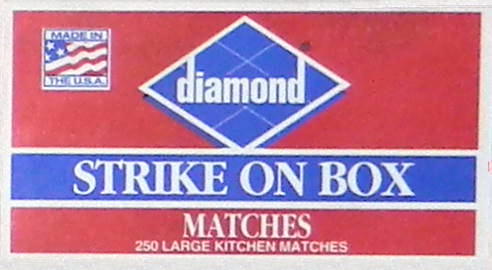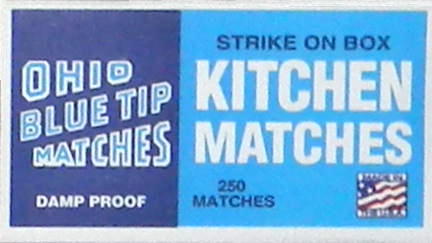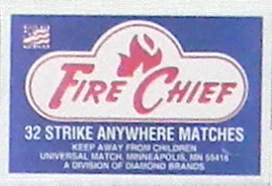


















Shelf Life of Matches
Copyright © November 8, 2024 by Robert Wayne Atkins, P.E.
All Rights Reserved.
Introduction
Since the year 2003 I have recommended that matches, and their striking strips, should be vacuum sealed in order to extend their useful shelf life.
However, matches do not need to be vacuum sealed if you are going to be using them within a few years of when you purchase them.
This article will discuss the shelf life of matches after 25 years and after 40 years.
Shelf Life Tests
I found a matchbook of paper matches that had been in a drawer for 40 years. The matchbook was a free "souvenir" matchbook of the type that were once commonly available at the checkout registers of many nice restaurants. When I saw the matchbook inside my drawer it reminded me of the occasion, and the year, when I ate at that restaurant and I realized that 40 years had passed. After I recovered from the shock of being reminded that I was now an old person, I decided to test the matches to see if they would still ignite.
I tore a paper match out of the matchbook and I attempted to ignite it on the striking strip attached to the matchbook. It would not ignite. I pulled it across the striking strip two more times until nothing remained of the match head.
I tried to ignite two more matches and those two matches would not ignite even after 3 pulls across the striking strip.
Then I tore a fourth match out of the 40 year old matchbook and I pulled it across a relatively "new" striking strip that was attached to a different book of matches. The match lighted immediately on the first pull. I removed two more matches and they both ignited on the first pull across the "new" striking strip without any difficulty.
During the 40 year period that the matchbook had been in one of my drawers, the temperature inside my home normally fluctuated between 65°F to 75°F. But there were rare occasions when we lost our power and the temperatures varied from 60°F to 80°F. I live in the southern USA and our air is normally a little more humid than some other areas of the USA.
I then decided to test some wooden stick matches that had been in long-term storage for 25 yeras in my attic. During 10 months of the year the temperature inside my attic normally varies from 50°F to 90°F (10°C to 32°C). During one month in the winter the temperature in my attic drops down into the 40s. During one month in the summer the temperature in my attic increases to the high 90s during the days.
All the match boxes that were stored in my attic were enclosed by the manufacturer in a thin cellophane piece of plastic. In addition, I had also put the boxes inside a black plastic garbage bag, and I had closed the top of the garbage bag in order to protect the matches from the normal humidity in the air.
Following is a summary of the results on the different wooden stick matches that I tested.
Diamond Kitchen Matches: The matches were 2.1 inches long. I tested 3 match sticks and all 3 matches easily ignited when I pulled them across the striking strip that was attached to the original box.
Ohio Blue Tip Damp Proof Kitchen Matches: The matches were 2.1 inches long. I tested 3 match sticks and all 3 matches easily ignited when I pulled them across the striking strip that was attached to the original box.
Fire Chief Strike Anywhere Matches: I had two sizes of these stick matches.
Long: I had a big box of long match sticks and each match was 2.1 inches long. I tried to strike 3 of the matches on three different surfaces and none of them would ignite. I then tried to strike 3 other matches on the striking strip attached to the original box and all 3 matches ignited.
Short: I had a small box of short match sticks and each match was 1.6 inches long. I tried to strike 3 of the matches on three different surfaces and none of them would ignite. I then tried to strike 3 other matches on the striking strip attached to the original box and all 3 matches ignited.
Generic Paper Matches: I also had one matchbook of 20 generic paper matches in the same black plastic garbage bag in my attic. I tested 3 paper matches and all 3 paper matches easily ignited when I pulled the matches across the striking strip that was attached to the original matchbook.
Brief Summary:
I suspected that the striking strip on my 40 year old book of paper matches that had been stored inside a drawer had gradually absorbed oxygen and humidity from the surrounding air and it could no longer be used to ignite a match.
I suspected that the one book of generic paper matches that had been in my attic for 25 years had been protected by the black garbage bag and its striking strip had not been continually exposed to a fresh supply of oxygen and humidity, and that striking strip could still be used to ignite a match.
I suspected that all the different wood stick matches that had been in my attic for 25 years had been protected by their original cellophane wrappers, and by the black garbage bag, and their striking strips had not been continually exposed to a fresh supply of oxygen and humidity, and those striking strips could still be used to ignite a match.
However, I suspected that the white tip on the strike anywhere matches slowly degraded during the 25 years in storage due to the type of chemical that was used to create the white tip and that a cellophane wrapper and a garbage bag was not adequate to protect that chemical from slowly degrading. I do not know exactly how long it took the white tip to become useless. But I do know that the white tip would not work correctly after 25 years even though it was protected by a cellophane wrapper and a black plastic garbage bag.
Match Composition
In order to better understand the reasons for the above results I searched the internet to find out how matches are made. The results are as follows.
Paper matches are also called safety matches.
The head of a paper match contains potassium chlorate and a little glue.
The striking surface, or strip, contains red phosphorus and some type of abrasive material such as glass powder.
When the head of a paper match is pulled across a striking surface then some of the red phosphorus on the striking strip is converted into white phosphorus and this ignites the potassium chlorate in the match head and it bursts into a flame.
Regardless of what you may read on the internet, an ordinary match head will not ignite if it is pulled across some sandpaper because sandpaper does not contain the necessary phosphorus chemical.
The potassium chlorate in a match head does not degrade with time.
However, the red phosphorus in a striking strip does degrade with time due to the oxygen and humidity in the air. If the striking strip has degraded then the match head will not burst into flame because the phosphorus on the striking strip is no longer capable of performing its original function.
"New" strike anywhere matches do not require a striking strip because the match head contains potassium chlorate and the white tip contains phosphorus sesquisulfide which is a form of red phosphorus. When the white tip of a strike anywhere match is pulled across almost any surface the two chemicals in the match head are forced together and the match head ignites. However, the phosphorus sesquisulfide in the white tip does degrade with the passage of time. Therefore an "old" strike anywhere match may need to be pulled across a striking strip in order to ignite it.
Conclusion
If you will be using your matches within a few years of when you buy them, then you do not need to vacuum-seal those matches.
However, if you purchase some matches for use during a future hard times event, then you should be aware that the striking strips will slowly degrade. And the white tip on a strike anywhere match will also slowly degrade.
Therefore, matchbooks of paper matches and their striking strips should be vacuum-sealed to significantly extend their shelf life.
And wooden stick matches and their striking strips should also be vacuum-sealed to ensure they will work when you actually need them.
If you can't vacuum-seal your matches, then you should at least store them inside a heavy-duty zipper freezer bag at normal room temperatures to help protect the matches and their striking strips from being constantly exposed to the fresh oxygen and the fresh humidly in the surrounding air.
The availability and the quality of the different brands and types of matches is constantly changing. If you are considering the purchase of some matches for a future hard times event then it might a good idea to invest in several different brands and types of matches. This would help you diversify your risk.
Respectfully,
Grandpappy.
Grandpappy's e-mail address is: RobertWayneAtkins@hotmail.com













































